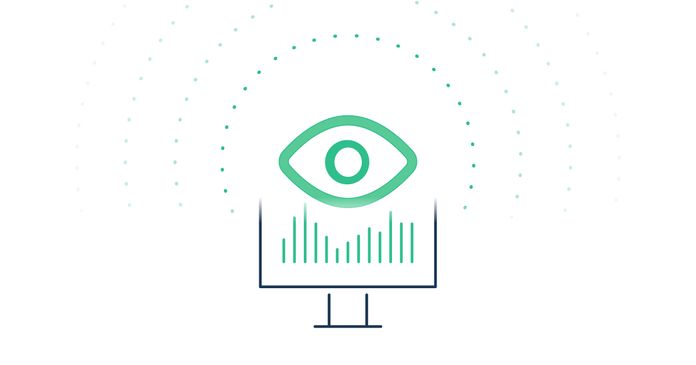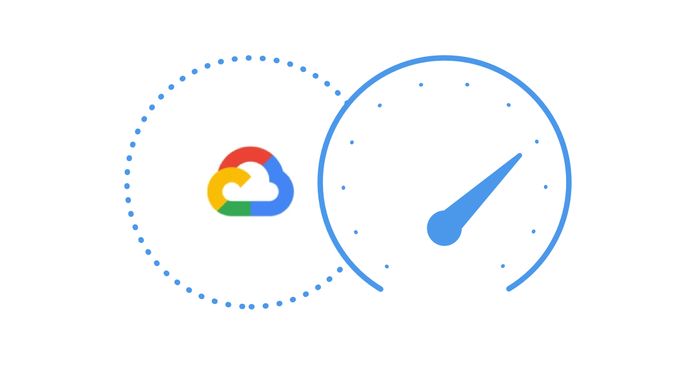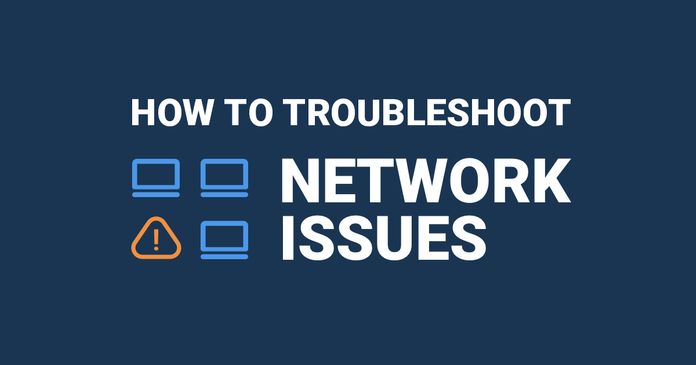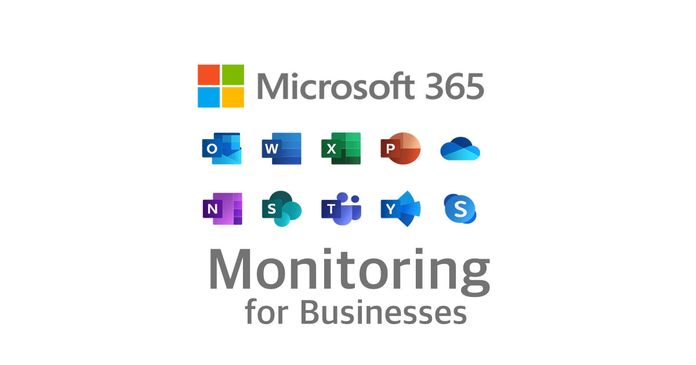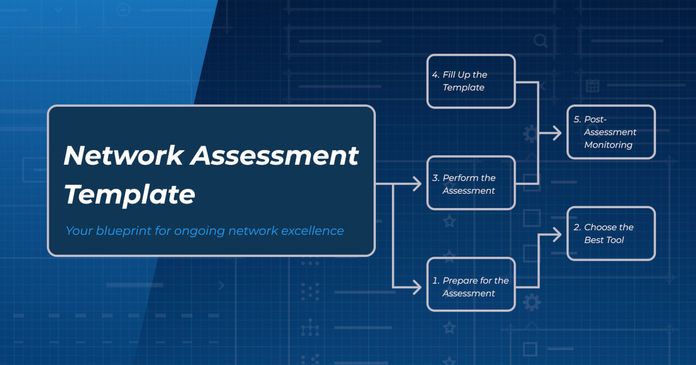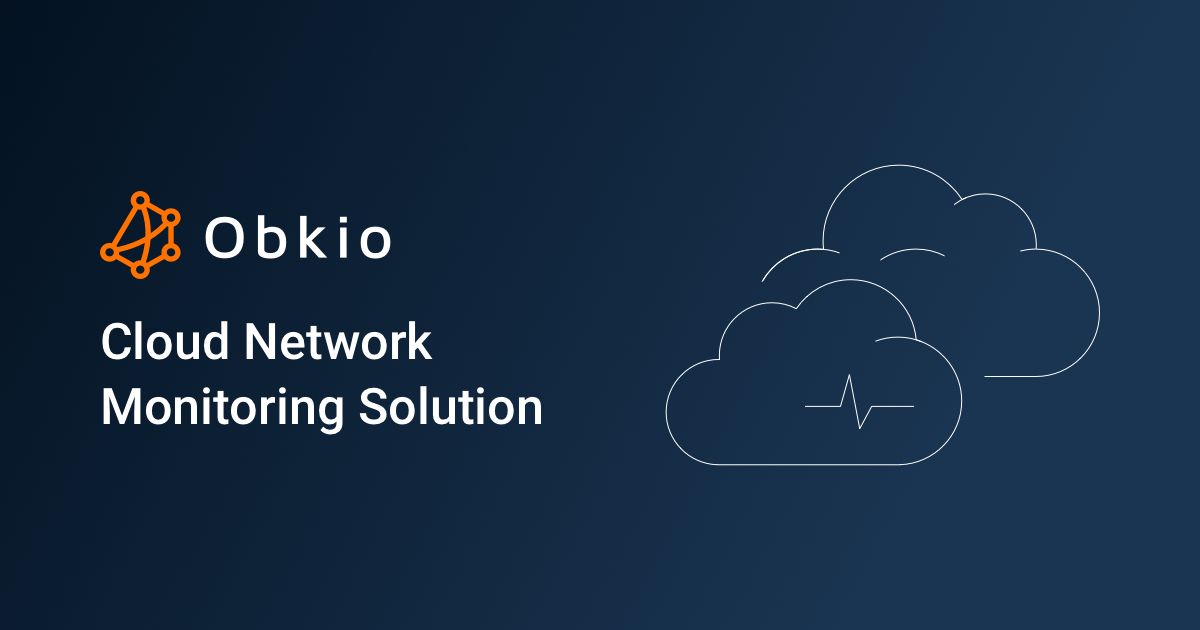Table of Contents
Table of Contents
As businesses increasingly rely on the power of the cloud, maintaining optimal performance is paramount. Enter network monitoring tools - the guiding stars that help IT pros navigate the expansive cosmos of Microsoft's cloud services with precision and confidence.
In this article, we're embarking on a comprehensive exploration into the world of Microsoft Cloud Monitoring using network monitoring tools. Whether you're an IT aficionado seeking to refine your cloud management prowess or a newcomer eager to learn the ropes, this deep dive promises to unlock the secrets of effective performance monitoring in the Microsoft cloud.
Throughout this article, we'll embark on a journey to unravel the key techniques that enable IT professionals to:
- Harness Network Monitoring Tools: Dive into the arsenal of network monitoring tools at your disposal, each designed to provide unique insights into your Microsoft cloud performance.
- Optimize Performance: Discover how to interpret performance data, diagnose network congestion, and optimize the delivery of cloud services to your end users.
- Troubleshoot Bottlenecks: Learn how to identify and address bottlenecks, latency issues, and network spikes that can impact the responsiveness of your cloud applications.
- Enhance User Experience: Explore strategies to proactively maintain a stellar user experience by ensuring smooth data flow and reduced downtime.
First, let’s make sure that we’re all on the same page.
Microsoft Cloud Monitoring refers to the process of observing, analyzing, and managing the performance, availability, security, and overall health of Microsoft's cloud-based services and resources. These cloud services are primarily offered through the Microsoft Azure platform, which encompasses a wide range of infrastructure, applications, and data storage solutions.
Microsoft Cloud Monitoring involves using specialized tools and techniques to gain insights into various aspects of the cloud environment, ensuring that it operates efficiently, securely, and in accordance with defined performance benchmarks. This monitoring process is crucial for IT professionals and organizations that rely on Microsoft's cloud services to deliver reliable and high-quality digital experiences to their users.
Key aspects of Microsoft Cloud Monitoring include:
- Performance Monitoring: This involves tracking and analyzing metrics related to resource utilization, response times, data transfer rates, and other performance indicators. It helps IT teams identify and address performance bottlenecks, optimize resource allocation, and maintain a consistent user experience.
- Availability and Uptime Monitoring: Monitoring tools help track the availability and uptime of cloud services and applications. Any downtime or service disruptions are promptly detected, allowing IT teams to take quick action to restore service and minimize impact.
- Security Monitoring: Security is a paramount concern in the cloud. Monitoring tools help detect and respond to security threats, unauthorized access attempts, and unusual activities within the cloud environment. They also assist in maintaining compliance with security regulations and best practices.
- Capacity Planning: By analyzing historical performance data and trends, monitoring helps IT professionals plan for future resource needs, scaling up or down as required to meet demand while controlling costs.
- Alerting and Notifications: Microsoft Cloud Monitoring tools can be configured to send alerts and notifications to IT teams or administrators when predefined thresholds are breached or anomalies are detected. This enables rapid response and issue resolution.
- Log Analysis: Monitoring involves analyzing logs and event data to troubleshoot issues, investigate incidents, and gain insights into system behaviour. This helps in understanding the root causes of performance problems and making informed decisions.
- User Experience Monitoring: Monitoring tools can simulate user interactions with cloud applications and services, providing insights into how users experience the system. This helps in identifying areas for improvement and optimizing the user journey.

In the world of cloud computing, keeping a watchful eye on your Microsoft Cloud services isn't just a good practice – it's a must. Think of it as your digital insurance policy, safeguarding the performance and reliability of your cloud-based operations.
While the specific services you monitor may vary based on your organization's needs, here are some key Microsoft Cloud services that you should consider monitoring:
- Azure Virtual Machines: Monitor the performance and availability of virtual machines (VMs) that host your applications. This includes tracking CPU, memory, disk usage, and network activity.
- Azure App Service: Monitor web applications hosted on Azure App Service. Track response times, request rates, error rates, and resource utilization.
- Azure SQL Database: Monitor the performance of your Azure SQL databases, including query performance, database throughput, and resource utilization.
- Azure Blob Storage: Monitor the availability and performance of your Azure Blob Storage accounts, ensuring efficient data storage and retrieval.
- Azure Cosmos DB: Monitor the performance of globally distributed databases, including response times, throughput, and latency.
- Azure Kubernetes Service (AKS): Monitor the performance and health of your Kubernetes clusters, including node health, pod status, and container metrics.
- Azure Functions: Monitor serverless applications hosted on Azure Functions. Track execution times, error rates, and resource consumption.
- Azure Active Directory: Monitor user authentication and access activity in Azure AD. Detect and respond to security threats and anomalous behaviour.
- Azure Networking Services: Monitor virtual networks, load balancers, and network traffic to ensure optimal connectivity and performance.
- Azure Key Vault: Monitor access and usage of secrets and keys stored in Azure Key Vault to ensure proper security and compliance.
- Azure Logic Apps: Monitor the execution of workflows and integrations in Azure Logic Apps to ensure they run smoothly.
- Azure Service Bus: Monitor message queues and topics in Azure Service Bus to ensure reliable communication between components.
- Azure Monitor and Application Insights: Utilize Azure Monitor and Application Insights to collect and analyze telemetry data from various Azure services, applications, and infrastructure components.
- Azure Security Center: Monitor and assess the security posture of your cloud environment, including identifying and remediating potential vulnerabilities.
- Azure Policy and Compliance: Monitor adherence to organizational policies and compliance requirements across your Azure resources.
These are just a few examples of the Microsoft Cloud services that you should consider monitoring. The specific services you monitor will depend on your organization's architecture, applications, and priorities. Effective monitoring helps you proactively identify and address issues, optimize performance, and ensure a reliable and secure cloud environment.
Learn how to keep your Azure cloud connections clear with this deep dive into Azure network monitoring. Optimize your network performance with Obkio.
Learn more

Say goodbye to network woes and hello to smooth cloud operations with Obkio's Network Monitoring tool. Whether you're navigating the Azure cosmos, taming your Office 365 ecosystem, or ensuring flawless Teams collaboration, Obkio has your back.
Unleash the power of real-time insights, pinpoint network bottlenecks, and elevate your Microsoft Cloud Monitoring game to new heights.

- 14-day free trial of all premium features
- Deploy in just 10 minutes
- Monitor performance in all key network locations
- Measure real-time network metrics
- Identify and troubleshoot live network problems
Embrace the future of cloud performance monitoring and embark on a journey to a faster, more reliable, and frustration-free cloud experience. Ready to conquer the cloud? Let's get started with Obkio today!

In the intricate realm of cloud computing, the significance of monitoring Microsoft Cloud performance cannot be overstated. As organizations continue to harness the power of the cloud to drive innovation and efficiency, ensuring the seamless operation and optimal performance of your cloud resources becomes paramount.
Let's delve into why monitoring Microsoft Cloud performance is not just a best practice, but a strategic imperative:
- User Experience is King: In a digital landscape defined by user expectations, a slow or unresponsive application can drive users away in seconds. Monitoring performance ensures that your cloud-based services deliver the responsiveness and reliability users demand, enhancing their satisfaction and loyalty.
- Proactive Issue Detection: Monitoring allows you to spot performance bottlenecks, resource constraints, and potential issues before they escalate into critical problems. This proactive approach minimizes downtime, service disruptions, and the subsequent impact on your operations.
- Cost Optimization: Monitoring empowers you to optimize resource allocation and usage. By identifying underutilized or overutilized resources, you can fine-tune your cloud environment to reduce costs while maintaining performance.
- Scalability and Growth: As your organization evolves, your cloud infrastructure needs to keep pace. Monitoring helps you understand usage patterns, anticipate growth, and scale resources appropriately to accommodate increased demand.
- Effective Troubleshooting: When issues arise, swift and accurate troubleshooting is essential. Monitoring provides insights into the root causes of problems, allowing your IT teams to diagnose and resolve issues more efficiently.
- Data-Driven Decision-Making: Performance data collected through monitoring offers invaluable insights. These insights inform strategic decisions, help you prioritize improvements, and guide investments in your cloud infrastructure.
- Optimized Resource Planning: With historical performance data at your fingertips, you can better plan for future resource needs. This foresight ensures that you allocate resources efficiently and avoid unexpected capacity constraints.
In essence, monitoring Microsoft Cloud performance empowers you to be in control, providing the insights and intelligence needed to drive successful cloud operations. It's not just about responding to issues – it's about being proactive, and strategic, and ensuring your cloud environment thrives in today's dynamic digital landscape.

Network issues can have a significant impact on the performance, availability, and overall functioning of Microsoft Cloud Services. The seamless operation of cloud services relies heavily on a stable and efficient network connection.
This connection between the Microsoft Cloud and Network Performance is what makes Microsoft Cloud Monitoring and Microsoft Network Monitoring so important. When network issues arise in the Microsoft Cloud, they can affect various aspects of your cloud environment:
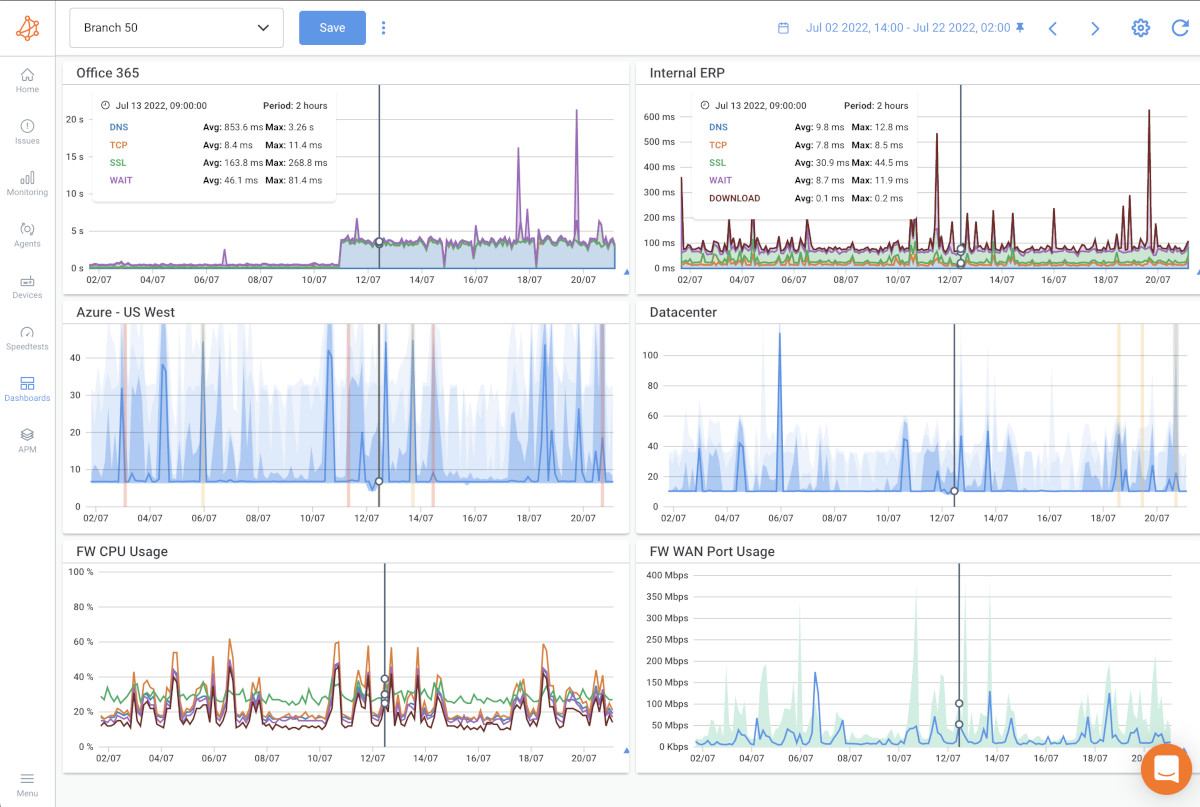
- Slow Performance: Network latency and congestion can lead to slow data transfer between your local infrastructure and Microsoft Cloud Services. This results in delays in accessing and transmitting data, which can affect application response times and user experience.
- Service Disruptions: Network outages or intermittent connectivity problems can cause service disruptions, making your cloud services unavailable to users. This can lead to downtime, loss of productivity, and potentially impact revenue-generating activities.
- Data Inconsistencies: Network issues during data synchronization between on-premises systems and cloud services can result in data inconsistencies or data corruption. This can lead to inaccurate reporting, data loss, and operational challenges.
- Scalability Challenges: Cloud services often require dynamic scaling to handle varying workloads. Network issues can impede the smooth scaling of resources, preventing your applications from effectively adapting to changing demands.
- Security Risks: Unstable network connections can expose your cloud services to security risks. Data breaches or unauthorized access might occur due to vulnerabilities introduced by network interruptions or failures.
- Application Dependencies: Many cloud services rely on interactions between different components and services. Network issues can disrupt these dependencies, causing cascading failures that affect multiple parts of your application.
- Multi-Region Deployments: For globally distributed cloud deployments, network issues can impact communication and data replication between different regions. This can lead to inconsistent data and performance disparities.
- User Experience: Network-related delays or errors can result in a poor user experience. Slow-loading web pages, unresponsive applications, and disrupted online services can frustrate users and lead to decreased user satisfaction.
- Resource Utilization: Network issues may cause resources, such as virtual machines or containers, to be held up due to communication bottlenecks. This underutilization affects cost efficiency and resource optimization.
To mitigate the impact of network issues on Microsoft Cloud Services, effective network monitoring and management are crucial. So how can you deploy and use the perfect network monitoring tools for your Microsoft Cloud monitoring needs? Let’s get into that!
When it comes to Microsoft Cloud Monitoring, a Network Monitoring tool (or Network Performance Monitoring tool) is an ideal companion. Network Monitoring tools provide crucial insights into the performance, connectivity, and health of your cloud environment. When integrated into your Microsoft Cloud Monitoring strategy, a network monitoring tool enhances your ability to ensure optimal performance and availability across your cloud services.
- Holistic Visibility: While Microsoft Cloud Monitoring tools focus on the performance of specific Azure services and resources, a network monitoring tool offers a broader perspective. It provides end-to-end visibility into the entire network infrastructure, from on-premises to the cloud, helping you identify potential network-related issues that can impact your cloud services.
- Early Issue Detection: Network monitoring tools enable you to proactively detect network anomalies, latency, packet loss, and other connectivity issues. By identifying these problems early, you can prevent or mitigate their impact on Microsoft Cloud Services, ensuring smooth operations and minimizing downtime.
- Comprehensive Performance Analysis: A network monitoring tool helps you measure network performance metrics such as bandwidth utilization, throughput, and response times. This data allows you to correlate network performance with the performance of your Microsoft Cloud Services, helping you troubleshoot and optimize resource allocation.
- Cloud Connectivity Assurance: As you extend your on-premises network to the cloud, ensuring reliable and secure connectivity becomes vital. A network monitoring tool monitors the connectivity between your local infrastructure and the Microsoft Cloud, helping you guarantee seamless data flow and access to cloud services.
- Multi-Cloud Environments: If you have a multi-cloud or hybrid network strategy involving Microsoft Azure and other cloud providers, a network monitoring tool can monitor network connectivity and performance across different cloud environments, providing a unified view of your network landscape.
- Real-time Alerts and Notifications: Network monitoring tools offer customizable alerts and notifications when network performance deviates from defined thresholds. This allows you to respond promptly to potential issues that may impact Microsoft Cloud Services, ensuring uninterrupted service.
- End-to-End Troubleshooting: When issues arise in your Microsoft Cloud Services, a network monitoring tool helps you pinpoint whether the problem lies in the network infrastructure. This reduces the time needed to diagnose and resolve issues, improving your mean time to resolution (MTTR).
- User Experience Enhancement: Network performance directly affects user experience. Monitoring the network ensures that your Microsoft Cloud Services deliver the responsiveness and reliability that users expect, enhancing their satisfaction and productivity.
Incorporating a network monitoring tool into your Microsoft Cloud Monitoring strategy provides a comprehensive and holistic approach to ensuring the performance, availability, and security of your cloud services. It empowers you to proactively manage network-related challenges and contribute to a seamless cloud experience for both your users and your IT team.
When it comes to Microsoft Cloud Monitoring and network performance optimization, Obkio’s Network Monitoring tool stands as the ultimate tool to amplify your capabilities and ensure your cloud environment thrives.
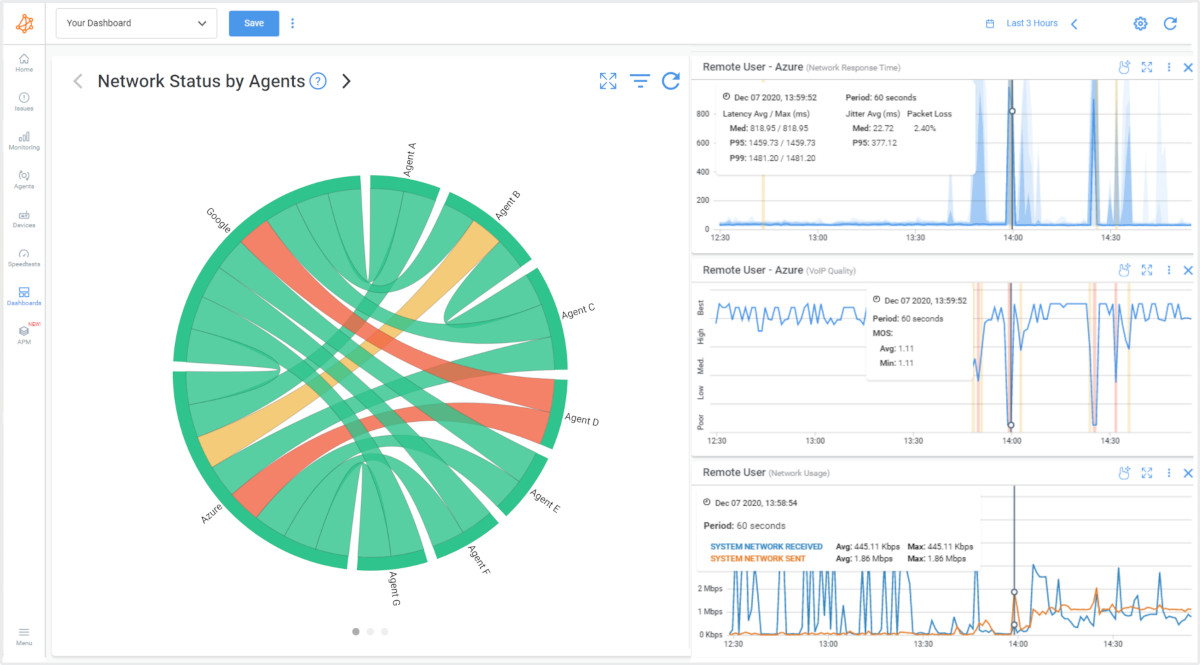
Holistic Insights, Unified Power:
Obkio's network monitoring tool seamlessly integrates with your Microsoft Cloud Services, offering an all-encompassing perspective of your cloud ecosystem. By combining the strengths of both tools, you gain a deeper understanding of how network performance influences your cloud operations.
Proactive Agility, Unparalleled Assurance:
Obkio's real-time insights into network anomalies, latency issues, and packet behaviour empower you to proactively address potential network bottlenecks before they can cast a shadow on your cloud services. The result? A harmonious orchestration of cloud performance and network prowess.
Efficiency Redefined, User Experience Elevated:
By optimizing network resource allocation, preventing downtime, and enhancing connectivity, Obkio contributes to a seamless user experience that keeps your users engaged and your IT team stress-free.
The Future of Cloud Excellence Awaits:
Unleash the power of Obkio alongside Microsoft Cloud Monitoring, and embark on a journey toward cloud excellence that's backed by real-time insights, proactive optimization, and a commitment to delivering unparalleled user experiences.
Don't just settle for monitoring; empower your cloud environment with Obkio's network monitoring tool, and watch as the synergy of Microsoft Cloud Services and network performance elevates your cloud operations to new heights. Embrace the future of cloud excellence with Obkio by your side – because when it comes to your cloud, every performance beat matters.

Keeping an eye on every aspect of your network is crucial when it comes to monitoring network and Microsoft Cloud performance. It's like being a seasoned network spy, always on the lookout for any potential issues across the WAN, LAN, or network devices.
This is where the Network Monitoring Agents come in handy. Obkio's Monitoring Agents are strategically deployed at key network locations, continuously monitoring performance between them.
When setting up Microsoft Cloud monitoring, it's important to monitor network performance between the Microsoft Cloud (Azure) and your on-premise infrastructure. To achieve this, you'll need to deploy at least two Monitoring Agents: one within the Microsoft Azure Cloud and another within your on-premise infrastructure.
- Microsoft Azure Monitoring Agent: The Azure Monitoring Agent is hosted and maintained by Obkio in the Microsoft Azure cloud infrastructure. It allows you to proactively monitor network performance between your local network to the Microsoft Azure network. They provide complete and continuous visibility so you can easily identify the source and cause of Azure network issues impacting your network performance.
- On-Premise Agent: These Monitoring Agents are deployed in your local network, in key network locations like your head office, branch office, data centers and network devices. They allow you to monitor network performance from your end up to Microsoft Azure. We recommend the Software (Linux, Windows, Docker) agent that can be installed on your favourite Linux distribution, including Amazon Linux and Amazon Linux 2.
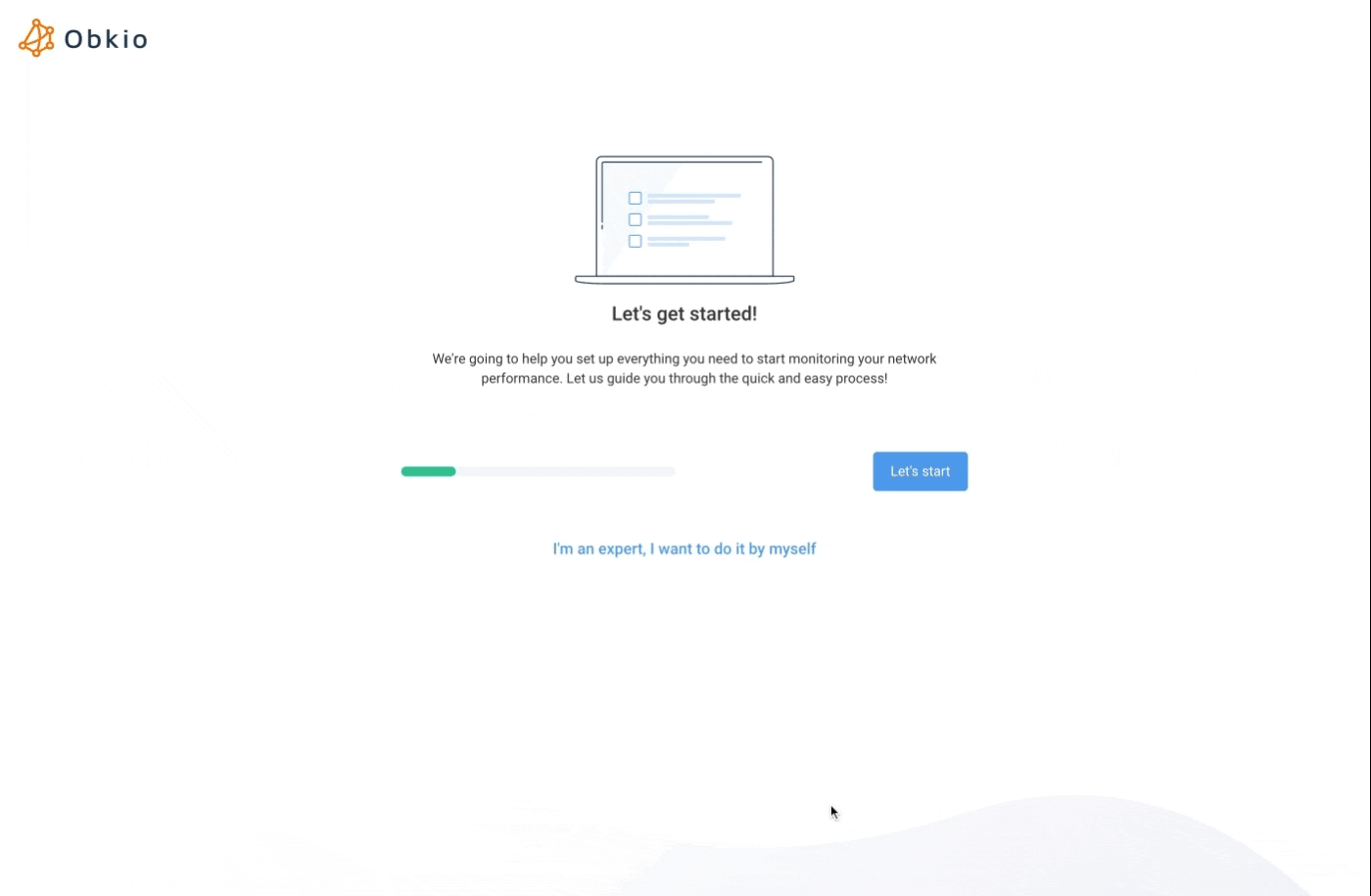
P.S. You can also use the Microsoft Azure Monitoring Agent to monitor:
Microsoft stores customer data in Microsoft's global cloud locations. So, when you’re looking to monitor performance up to the Microsoft Cloud, it’s important to choose a Monitoring Agent that has been deployed in the Data Center located closest to the Microsoft Data Center closest to you.
For Example:
- You want to monitor Microsoft Azure performance for your business based in Canada, so first, you need to find the location of a Microsoft Data Center in Canada.
- In Canada, Microsoft's Data Centers are located in Quebec City and Toronto - so you need to choose a Public Monitoring Agent hosted closest to one of those locations.
- Obkio’s Microsoft Azure Monitoring Agents are presently located in many locations, including one in Quebec City!
So when you’re deploying your Agent, make sure to choose the Quebec City Azure Agent, to monitor the performance of your Microsoft Azure service from Microsoft’s Quebec City Data Center!
You should always deploy a minimum of two Agents to more accurately compare data and identify network issues affecting different Microsoft Cloud services and apps in different network locations.
For example:
- If you’re monitoring Microsoft Teams network performance between your head office and your Internet, use one Agent in your Head Office and 2 Agents to monitor Internet performance (for example, an Azure Agent and an AWS Agent).
- This way, if you have a network problem, you can easily see if that same problem is affecting all your sites or just one.
- If the problem is affecting all your sites, having multiple Agents allows you to collect the most accurate data to troubleshoot, as well as create a comparison point.

Once the Monitoring Agents are installed, you're almost done! Two configurations are required in the App:
- The agents must be in the same Network. When two agents are in the same Network, they will communicate using private IPs instead of Public IPs.
- A Network Monitoring Template must be configured to create the network performance monitoring session.
Once Obkio’s Monitoring Agents are deployed and configured, they will begin exchanging synthetic UDP traffic every 500ms to continuously measure network and Microsoft Cloud performance. This is when the real monitoring happens!
At this point, you’ll want to define key performance metrics that are important for your Microsoft Cloud Monitoring. These network metrics provide a clear picture of the health and performance of your cloud environment.
When selecting metrics, consider the following:
- Response Time: Response time measures the time it takes for a request to be processed and responded to by your cloud services. Slow response times can lead to user frustration and decreased satisfaction. Monitoring network response time helps ensure a smooth user experience and timely interactions with your applications.
- Throughput: Throughput refers to the rate at which data is transferred between your systems and the cloud. High throughput is crucial for efficient data transfer, especially for data-intensive applications or services that rely on quick data synchronization. Monitoring throughput helps prevent data bottlenecks and ensures timely processing.
- Resource Utilization: Resource utilization tracks the usage of CPU, memory, and disk of your virtual machines and cloud resources. Monitoring resource utilization helps you understand how efficiently your cloud services are using available resources. It allows you to optimize resource allocation and prevent resource exhaustion that can lead to performance degradation.
- Network Latency: Network latency measures the time it takes for data to travel between your on-premises infrastructure and the cloud. High network latency can introduce delays in data transfer and application communication. Monitoring network latency helps you identify connectivity issues and optimize data pathways for efficient communication.
- Error Rates: Error rates quantify the frequency of errors or failed requests within your cloud services. Elevated error rates can indicate issues in application logic, data integrity, or service availability. Monitoring error rates helps you identify and address potential bugs or performance bottlenecks.
- Packet Loss: Packet loss measures the percentage of data packets that are lost or fail to reach their destination during transmission. High packet loss rates can indicate network congestion, poor connectivity, or hardware issues. Monitoring packet loss helps you identify potential network problems that may affect the reliability and quality of your cloud services.
- Jitter: Jitter refers to the variation in the delay of packet delivery in a network. Excessive jitter can result in inconsistent data transfer and lead to audio and video quality issues in real-time applications. Monitoring jitter helps ensure stable and smooth communication, especially for services like voice and video conferencing.
- Bandwidth Utilization: Bandwidth utilization measures the percentage of available network bandwidth that is being used. Monitoring bandwidth utilization helps you understand how much network capacity is being consumed by your cloud services. This information is vital for optimizing resource allocation and planning for future scalability.
- Availability and Uptime: Network availability and uptime measure the percentage of time your cloud services are operational and accessible. High availability ensures that your services are consistently accessible to users. Monitoring availability helps you detect and respond to service disruptions, minimizing downtime and ensuring business continuity.
- Security Events: Security events encompass unauthorized access attempts, breaches, or other suspicious activities within your cloud environment. Monitoring security events is crucial for maintaining the integrity and security of your cloud services. Detecting and responding to security threats promptly helps prevent data breaches and unauthorized access.
- Scalability Metrics: Scalability metrics measure how well your cloud services can handle increased loads and traffic. Monitoring scalability metrics helps you assess the ability of your cloud resources to scale up or down based on demand. This ensures that your applications can accommodate varying workloads without compromising performance.
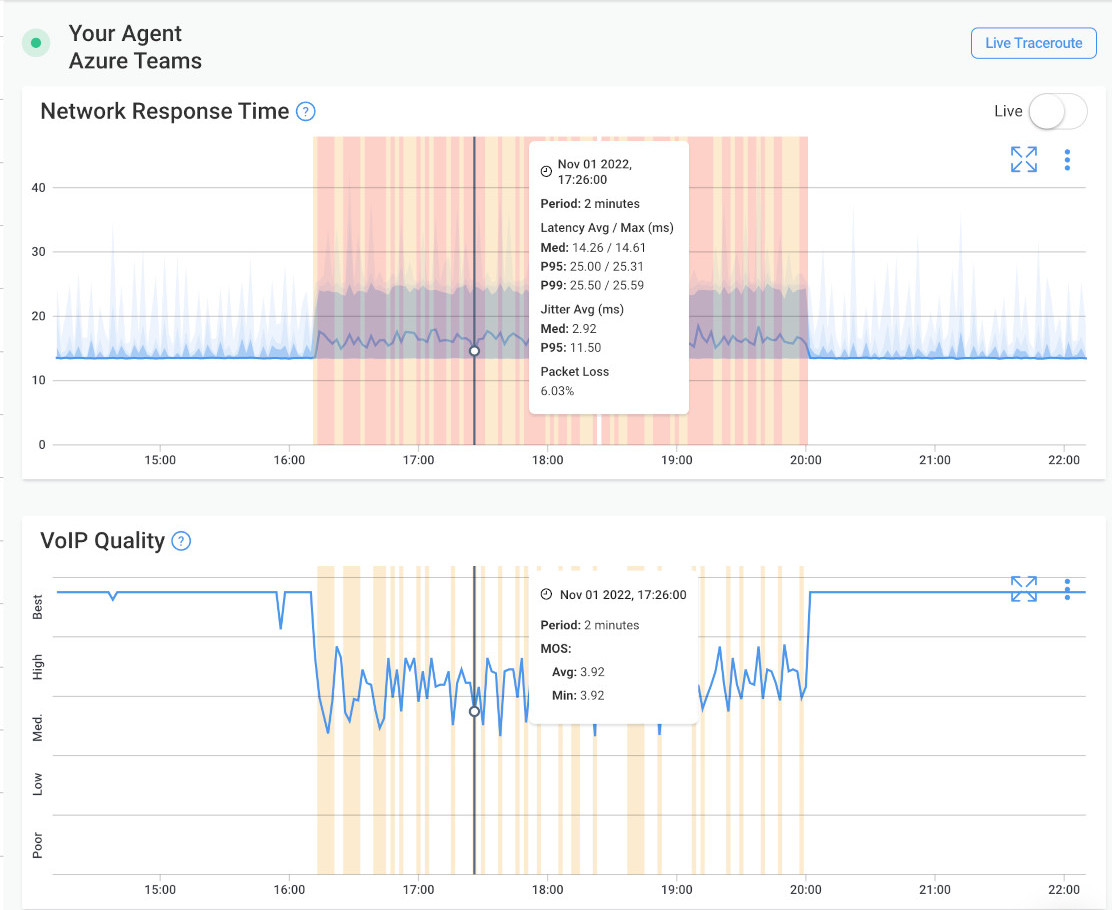

By tracking and analyzing these key performance metrics, you gain valuable insights into the health, performance, and user experience of your Microsoft Cloud Services. A well-rounded understanding of these metrics empowers you to optimize resources, identify issues, and make informed decisions to ensure the successful operation of your cloud environment.
Once you've defined your key performance metrics, configure alerts and notifications within Obkio’s app to receive timely information about potential issues. Consider the following when setting up alerts:
- Thresholds: Set specific thresholds for each metric. When a metric crosses these thresholds, an alert is triggered. Thresholds should be based on acceptable performance ranges for your applications.
- Severity Levels: Define different severity levels for alerts based on the impact of the issue. This helps prioritize responses and allocate resources effectively.
- Notification Channels: Choose how you want to be notified when an alert is triggered. Options include email, SMS, Slack, or integrating with incident management systems.
- Escalation Policies: Establish escalation paths for alerts. If an issue isn't addressed within a certain timeframe, the alert can be escalated to higher-level personnel.
Establishing network baselines and thresholds is essential for effective alerting and understanding what constitutes normal versus abnormal behaviour. Here's how to do it:
- Baseline Creation: Monitor your cloud environment over a period of time to establish baseline performance patterns. Baselines represent normal behaviour and help you set appropriate thresholds. Obkio’s Network Monitoring tool will continuously monitor performance to establish the baseline performance metrics for you.
- Dynamic Thresholds: Consider using dynamic thresholds that adjust based on historical data. This prevents unnecessary alerts triggered by temporary spikes.
Tuning and Refinement: Regularly review and refine your baselines and thresholds as your cloud environment evolves. Adjust them based on changes in usage patterns or application updates.
By carefully defining key performance metrics, configuring network monitoring alerts, and establishing accurate baselines and thresholds, you'll ensure that your Microsoft Cloud Monitoring strategy is proactive, responsive, and tailored to your specific cloud environment.


When it comes to the ultimate Microsoft Cloud Monitoring strategy, you need to monitor your network devices as well as your cloud performance.
While Microsoft Cloud Monitoring tools focus on the performance and health of your cloud-based services and resources, network device monitoring extends your visibility to the network infrastructure that connects your on-premises systems with the cloud.
The Network Device Monitoring feature inside of Obkio’s Network Monitoring Software is the key tool for troubleshooting performance issues.
Is a fast and easy solution to get detailed information about the performance of your core network devices to quickly and proactively pinpoint and troubleshoot network device issues like congestion, high CPU and interface errors.
Once you’ve installed your monitoring agents, you can then start monitoring your network devices using SNMP by adding the devices inside the Obkio App. The device must support SNMP. Obkio supports all versions of SNMP (v1, v2c and v3) and of course, read-only access is needed. Learn more about the supported devices here.
- End-to-End Visibility: Network device monitoring provides a holistic view of the entire data pathway, from your local network to the Microsoft Cloud. This visibility helps you identify potential network-related bottlenecks, latency issues, or connectivity problems that can impact the performance of your cloud services.
- Connection Reliability: Microsoft Cloud services heavily rely on a stable and efficient network connection. Monitoring network devices ensures that your cloud services have reliable and continuous connectivity, minimizing the risk of service disruptions or downtime.
- Diagnosis and Troubleshooting: When issues arise with your cloud services, network device monitoring allows you to determine whether the problem lies within your local network or the cloud. This knowledge speeds up troubleshooting efforts and reduces mean time to resolution (MTTR).
- Resource Optimization: Monitoring network devices helps you identify areas of congestion or inefficient network paths. By optimizing your network infrastructure, you can ensure smooth data transfer to and from Microsoft Cloud Services, improving overall performance.
- Multi-Cloud Environments: If your organization uses multiple cloud providers or has hybrid cloud setups, network device monitoring ensures that data flows seamlessly between different cloud environments, contributing to a cohesive and well-connected cloud architecture.
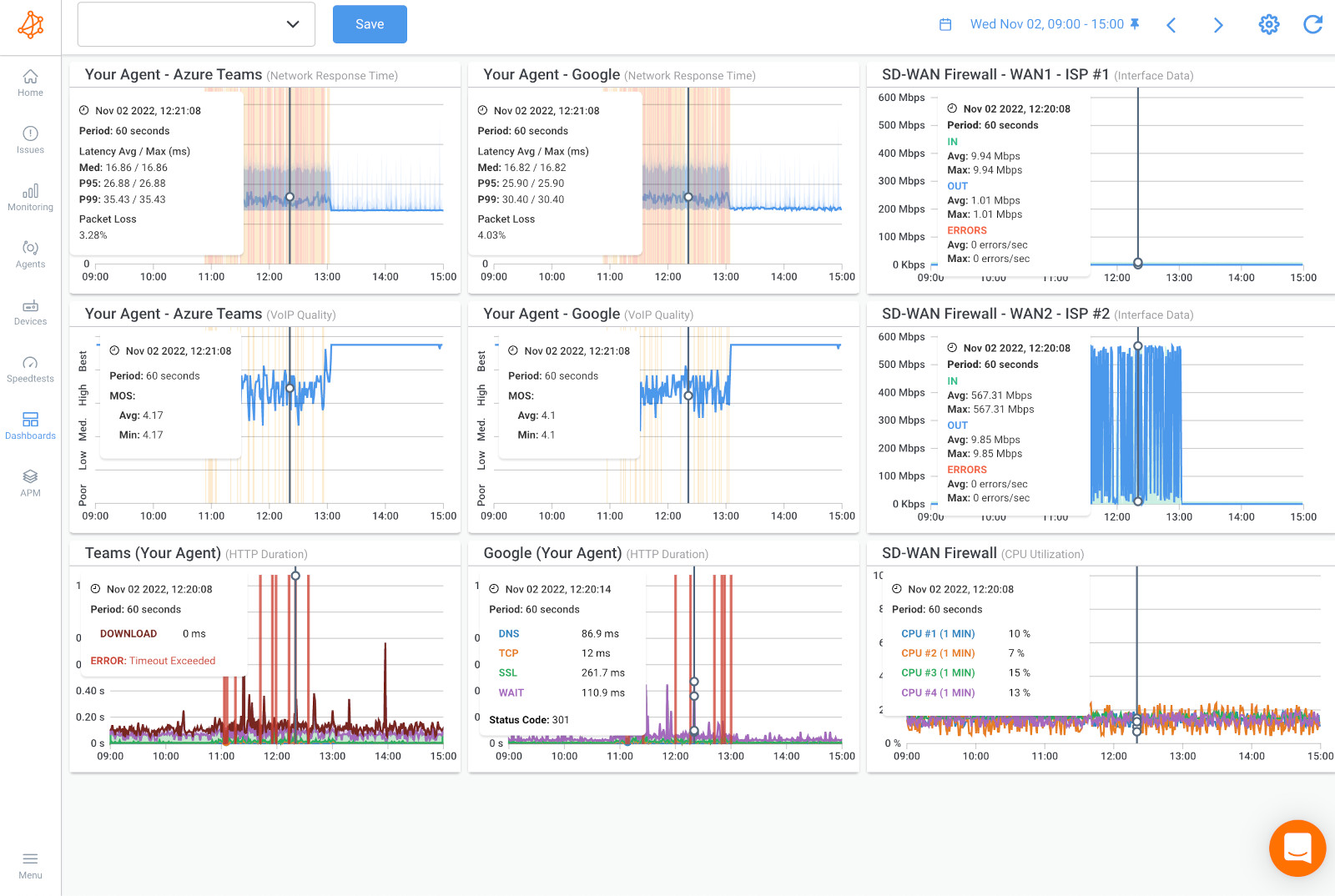
When it comes to Microsoft Cloud Monitoring, it's important to monitor various network devices that play a crucial role in connecting your on-premises infrastructure with the cloud. Here's a list of network devices you should consider monitoring to ensure optimal performance and connectivity for your Microsoft Cloud Services:
- Routers: Routers are essential for directing network traffic between your local network and the cloud. Monitoring routers helps ensure efficient data routing and connectivity.
- Switches: Switches facilitate local network communication and data transfer. Monitoring switches helps identify network congestion and ensures smooth data flow.
- Firewalls: Firewalls protect your network from unauthorized access and cyber threats. Monitoring firewalls helps detect potential security breaches and ensures the secure transmission of data to and from the cloud.
- Load Balancers: Load balancers distribute network traffic across multiple servers or instances. Monitoring load balancers helps optimize resource utilization and prevent the overloading of specific components.
- Gateways: Gateways connect different network protocols or networks. Monitoring gateways helps ensure seamless communication between your local network and the cloud.
- Proxy Servers: Proxy servers intercept and forward network requests. Monitoring proxy servers helps optimize content delivery and ensures efficient data retrieval from the cloud.
- WAN Optimizers: WAN optimizers enhance network performance by reducing latency and optimizing data transfer. Monitoring WAN optimizers helps ensure efficient data synchronization with cloud services.
- VPN Concentrators: VPN concentrators establish secure connections between remote locations and the cloud. Monitoring VPN concentrators helps ensure secure and reliable communication.
- Network Load Balancers (Azure Load Balancer): In the context of Microsoft Azure, network load balancers distribute incoming network traffic to Azure resources. Monitoring Azure Load Balancer ensures even traffic distribution and high availability of cloud services.
- Virtual Network Gateways (Azure Virtual Network Gateway): Virtual network gateways enable secure communication between on-premises networks and Azure Virtual Networks. Monitoring virtual network gateways ensures reliable connectivity and secure data transmission.
- ExpressRoute Gateways (Azure ExpressRoute): ExpressRoute gateways provide dedicated network connections from on-premises networks to Azure. Monitoring ExpressRoute gateways helps ensure high-speed and low-latency connections.
- Application Delivery Controllers: Application delivery controllers optimize application performance by managing and distributing application traffic. Monitoring ADCs ensures efficient application delivery from the cloud.
- DNS Servers: DNS servers translate domain names into IP addresses. Monitoring DNS servers helps ensure smooth and efficient resolution of domain names for cloud services.
By monitoring these network devices, you gain insights into the performance, availability, and security of the network infrastructure that connects your on-premises systems with Microsoft Cloud Services. This comprehensive network monitoring approach contributes to a seamless and reliable cloud environment.
Effectively monitoring your Microsoft Cloud environment goes beyond tracking individual components; it involves gaining insights into the performance of every layer that constitutes your cloud stack. Each layer contributes to the overall user experience and business functionality, and monitoring them collectively enables you to proactively detect and address issues before they escalate.
The network layer serves as the backbone connecting all components of your cloud environment. Monitoring network performance is crucial to ensure data flows smoothly between users, devices, and cloud resources.
Monitoring Focus:
- Latency: Measure network latency to ensure timely data transmission and quick response times.
- Packet Loss: Monitor packet loss to identify potential connectivity issues affecting data integrity.
- Bandwidth Utilization: Measure bandwidth usage to optimize resource allocation and prevent congestion.
- Jitter: Measure jitter to maintain consistent data delivery for real-time applications.
The infrastructure layer comprises virtual machines, storage, databases, and other resources. Monitoring infrastructure performance ensures these components operate efficiently and support application demands.
Monitoring Focus:
- Resource Utilization: Measure CPU usage, memory, disk usage, and other resource metrics to prevent overutilization or underutilization.
- Storage Performance: Track read and write operations, IOPS, and latency to maintain optimal storage performance.
- Database Queries: Monitor query performance and execution times to optimize database interactions.
Applications directly impact user experiences. Monitoring application performance helps identify bottlenecks, bugs, or inefficient code that might affect functionality.
Monitoring Focus:
- Response Times: Measure application response times to ensure fast and seamless user interactions.
- Error Rates: Track error rates and exceptions to promptly identify and resolve issues affecting application stability.
- Transaction Monitoring: Monitor user transactions to identify patterns and potential performance slowdowns.
Cloud services, including those offered by Microsoft, play a pivotal role in your cloud stack. Monitoring services ensure they meet service level agreements (SLAs) and deliver optimal functionality.
Monitoring Focus:
- Service Availability: Monitor service uptime and downtime to ensure consistent availability for users.
- API Performance: Track API response times and error rates to detect service-level degradation.
- Service Metrics: Monitor service-specific metrics provided by Microsoft Cloud services (SLA monitoring) to ensure compliance with SLAs.
By monitoring all layers of your cloud stack, you gain a holistic view of your Microsoft Cloud environment's performance. This proactive approach empowers you to identify and address potential issues across the network, infrastructure, applications, and services before they impact user experiences or business operations.
Comprehensive monitoring enables your organization to deliver optimal performance, maximize resource utilization, and provide a seamless user journey across the entire Microsoft Cloud landscape.
Discover the secrets to successful cloud network monitoring! Unleash the power of best practices & optimize performance with Obkio. Read more now!
Learn more

Several factors can impact the performance and availability of Microsoft Cloud services. Understanding these potential issues is essential for effective Microsoft Cloud Monitoring and ensuring a smooth user experience. Here are some common issues that can affect Microsoft Cloud services and performance:
- Network Congestion: Heavy network traffic or network congestion can lead to slow data transfer and increased latency, affecting the responsiveness of cloud services.
- Bandwidth Limitations: Insufficient network bandwidth can lead to reduced data transfer rates, impacting the speed at which cloud services operate.
- Network Latency: High network latency can result in delays in data transmission and application response times, negatively impacting user experience.
- Data Transfer Bottlenecks: Slow data transfer between your on-premises systems and cloud resources can lead to delays in data synchronization and processing.
- Geographic Latency: Users located far from data centers may experience slower performance due to the physical distance data has to travel.
- Resource Underutilization: Poor allocation of cloud resources can lead to unused capacity and inefficiencies, impacting cost-effectiveness and performance.
- Resource Overutilization: Overloading cloud resources can cause performance degradation, slow response times, and potential service disruptions.
- Inadequate Scaling: Failure to scale resources appropriately can result in performance slowdowns during peak usage periods or increased workloads.
- Configuration Errors: Incorrect settings or configurations for cloud resources may lead to suboptimal performance or security vulnerabilities.
- Data Center Outages: Unplanned outages in Microsoft's data centers can cause service unavailability, disrupting user access to cloud services.
- Service Degradation: Cloud services may experience reduced performance or degraded functionality due to software updates, maintenance, or infrastructure issues.
- Software Bugs: Glitches or bugs in cloud applications can cause errors, crashes, or unexpected behaviour, impacting the user experience and performance.
- API Limitations: Exceeding API rate limits or encountering API errors can disrupt integrations and data flow between different services.
- External Dependencies: Cloud services relying on external APIs or third-party services may be affected if those dependencies experience issues.
- Inadequate Monitoring and Management: Lacking comprehensive monitoring and management practices can delay issue detection and resolution, prolonging performance problems.
- Security Breaches: Unauthorized access, data breaches, or vulnerabilities can compromise the security and confidentiality of cloud services and user data.
- Distributed Denial of Service (DDoS) Attacks: Malicious attacks overwhelming cloud services can lead to unavailability and performance degradation.
- Data Consistency Issues: Inconsistent data synchronization between cloud instances or databases can result in errors and discrepancies within applications.
Effective Microsoft Cloud Monitoring involves proactively identifying and addressing these potential issues to ensure the optimal performance, availability, and security of your cloud services. By staying vigilant and leveraging monitoring tools and strategies, you can mitigate the impact of these challenges and deliver a reliable and seamless user experience.
Troubleshooting internal Microsoft Cloud performance issues versus external issues involves distinguishing between problems that originate within your organization's environment and those that stem from external factors, such as Microsoft's infrastructure or third-party services.
Effectively identifying and resolving these issues requires different approaches and considerations.
1. Identification:
Internal performance issues often manifest as slow response times, application errors, or degraded user experience. Users within your organization may report issues with accessing Microsoft Cloud services or applications.
2. Diagnosis:
- Monitor Metrics: Utilize Obkio’s network monitoring tool to track performance metrics, such as latency, resource utilization, and error rates, within your organization's network and infrastructure.
- Analyze Logs: Examine logs and error messages generated by applications and services to pinpoint the root cause of performance problems.
- Check Network Health: Assess the health of your internal network, routers, switches, and firewalls for potential bottlenecks or configuration issues.
3. Common Causes:
- Network Congestion: Overloaded local network or inefficient routing causing data congestion.
- Resource Underutilization: Improper allocation of resources leading to inefficiencies.
- Application Bugs: Software bugs or coding issues impacting application performance.
- Configuration Errors: Incorrect settings affecting the performance of Microsoft Cloud services.
4. Resolution:
- Optimize Resources: Adjust resource allocation and scaling strategies to match workload demands.
- Code Optimization: Fix application code issues or optimize queries to improve performance.
- Network Optimization: Identify and resolve network bottlenecks or latency problems.
- Configuration Review: Review and correct configuration settings for cloud services and applications.
1. Identification:
External performance issues are often observed as widespread outages, connectivity problems, or latency across multiple users and locations.
2. Diagnosis:
- Check Service Status: Refer to the Microsoft Service Health Dashboard to check if there are reported outages or issues with specific Microsoft Cloud services.
- Monitor Internet Connectivity: Ensure your organization's Internet connection is stable and not causing intermittent Internet connectivity problems.
- External Dependency Analysis: Investigate third-party services or dependencies that may be affecting your Microsoft Cloud services.
3. Common Causes:
- Microsoft Service Outages: Widespread disruptions due to maintenance, technical issues, or updates on Microsoft's end.
- Internet Connectivity: Slow or unstable Internet connection impacting cloud service access.
- Third-Party Integration Issues: Problems with third-party applications or services integrated with Microsoft Cloud.
- Geographical Latency: Users located far from data centers may experience higher latency.
4. Resolution:
- Monitor Service Health: Keep an eye on Microsoft's official service health updates for notifications on service restoration.
- Contact Support: Reach out to Microsoft support for assistance and information during service disruptions.
- Address Third-Party Dependencies: Investigate and address issues with third-party services that may be affecting your Microsoft Cloud performance.
In both cases, effective troubleshooting involves a combination of monitoring, analysis, and collaboration with relevant stakeholders, including your IT team, Microsoft support, and third-party service providers. The goal is to quickly identify the underlying causes of performance issues and take appropriate actions to restore optimal performance and user experience.
Learn how to troubleshoot network issues by identifying where, what, why network problems occur with Network Troubleshooting tools.
Learn more

Optimizing performance for various Microsoft Cloud applications and services requires a combination of best practices, monitoring, and proactive management. Once you’ve deployed your Microsoft Cloud Monitoring setup and identified any performance issues, it’s time to take steps to troubleshoot and optimize performance.
Here's a guide on how to optimize performance for different Microsoft Cloud apps and services:
- Rightsize VMs: Choose VM sizes based on workload requirements to avoid overprovisioning or underutilization.
- Use Managed Disks: Opt for managed disks for better reliability, scalability, and performance.
- Utilize Availability Sets: Distribute VMs across availability sets to ensure high availability and fault tolerance.
- Enable Auto-Scaling: Use Azure Auto-Scaling to adjust VM instances based on demand, ensuring efficient resource utilization.
- Optimize Code: Optimize application code for performance and resource efficiency.
- Use Caching: Leverage Azure Redis Cache for caching frequently accessed data and improving response times.
- Scale Automatically: Configure auto-scaling based on metrics like CPU usage to handle varying workloads.
- Implement Content Delivery Networks (CDNs): Utilize Azure CDN to deliver content faster to users globally.
- Indexing: Properly index database tables to improve query performance.
- Query Optimization: Optimize queries to reduce database load and improve response times.
- Monitor Performance: Use Obkio’s Network Monitoring tool to identify bottlenecks.
- Configure DTUs: Choose the appropriate Database Throughput Units (DTUs) to match workload requirements.
- Use Cached Mode: In Outlook, enable cached mode to reduce network traffic and improve email access.
- Optimize SharePoint: Use content delivery networks, minimize large file uploads, and optimize page load times.
- Limit Add-Ins: Minimize the use of browser or application add-ins that can slow down performance.
Discover the art of seamless Microsoft 365 monitoring. Elevate performance, troubleshoot issues, and optimize networks for a superior user experience.
Learn more

- Optimize Network Bandwidth: Use QoS settings to prioritize Teams traffic and reduce latency.
- Limit Active Channels: Avoid excessive concurrent active channels to prevent performance degradation.
- Monitor Call Quality: Use Obkio’s VoIP Monitoring features to monitor VoIP quality and troubleshoot audio/video issues.
Learn how to monitor Microsoft Teams performance & connection issues like Microsoft Teams “We’re sorry - we’ve run into an issue” & “something went wrong.”
Learn more

- Resource Allocation: Configure resource limits and requests for containers to avoid resource contention.
- Horizontal Pod Autoscaling: Set up autoscaling for pods based on CPU or memory usage to handle varying loads.
- Monitor Cluster Health: Use Azure Monitor and Kubernetes dashboard to monitor cluster health and performance.
- Optimize Code: Write efficient and concise code to minimize execution time and resource usage.
- Use Dependency Injection: Utilize dependency injection for better code maintainability and performance.
- Monitor and Optimize Cold Starts: Monitor cold starts and optimize warm-up strategies to reduce latency.
- Choose Consistency Levels: Select the appropriate consistency level based on your application's requirements.
- Partition Key Design: Design partition keys to evenly distribute data and avoid "hot" partitions.
- Monitor Request Units (RUs): Monitor and adjust RUs to ensure optimal performance and avoid throttling.
- Optimize Queries: Optimize Power Query M and DAX queries for efficient data retrieval and processing.
- Use DirectQuery: Use DirectQuery mode for large datasets to minimize data imports and improve performance.
- Optimize Data Models: Keep data models simple and remove unnecessary columns to improve report load times.
- Optimize Code: Write efficient and concise code to minimize execution time and resource usage.
- Use Dependency Injection: Utilize dependency injection for better code maintainability and performance.
- Monitor and Optimize Cold Starts: Monitor cold starts and optimize warm-up strategies to reduce latency.

- Choose Consistency Levels: Select the appropriate consistency level based on your application's requirements.
- Partition Key Design: Design partition keys to evenly distribute data and avoid "hot" partitions.
- Monitor Request Units (RUs): Monitor and adjust RUs to ensure optimal performance and avoid throttling.
- Optimize Queries: Optimize Power Query M and DAX queries for efficient data retrieval and processing.
- Use DirectQuery: Use DirectQuery mode for large datasets to minimize data imports and improve performance.
- Optimize Data Models: Keep data models simple and remove unnecessary columns to improve report load times.
- Optimize Workflow: Streamline and optimize the workflow logic to reduce execution time.
- Minimize Dependencies: Limit the use of external connectors to reduce network latency.
- Error Handling: Implement efficient error handling to prevent performance degradation due to failures.
- Use Federation: Implement single sign-on (SSO) and federation to improve user authentication performance.
- Role-Based Access Control: Optimize access control policies to reduce unnecessary authentication requests.
- Monitor and Optimize Authentication: Use Azure AD monitoring tools to identify and address authentication issues.
- Choose the Right Storage Type: Select the appropriate storage type (blob, table, queue) based on data access patterns.
- Use Content Delivery Networks (CDNs): Utilize Azure CDN to distribute content and improve data delivery. *Optimize Storage Design: Design storage structures to avoid hotspots and optimize data access.
In this section, we delve into real-world use cases that illustrate how organizations can leverage Microsoft Cloud services to overcome various obstacles, enhance performance, and ensure the reliability and security of their applications and services. From troubleshooting network latency to scaling resources, detecting security threats, and improving user experience, these scenarios highlight practical strategies and solutions that can be applied to empower your organization in the realm of Microsoft Cloud services.
Let's explore how these use cases provide insights and actionable steps for achieving optimal performance and success in the cloud.
Scenario:
Users across different locations report slow response times when accessing a critical Microsoft Azure application.
Solution:
- Monitor Network Path: Use Obkio’s Network Monitoring tool to analyze the network path between users and the Azure application. Identify points of latency or congestion.
- Optimize Data Routes: Adjust routing configurations, utilize content delivery networks (CDNs), or consider using Azure ExpressRoute to reduce latency and improve data delivery.
- Implement QoS: Configure Quality of Service (QoS) settings to prioritize application traffic over the network.

Scenario:
An e-commerce company experiences significant spikes in traffic during seasonal sales, causing performance degradation in its Azure-hosted website.
Solution:
- Auto-Scaling: Implement Azure Auto-Scaling to automatically add resources (e.g., virtual machines) during traffic spikes and scale down when demand decreases.
- Load Balancing: Deploy Azure Load Balancer to distribute traffic evenly across multiple instances, preventing overload on a single server.
- Caching: Utilize Azure Redis Cache to store frequently accessed data, reducing the load on the backend and improving response times.
Scenario:
Unusual patterns of activity are detected in an organization's Microsoft 365 environment, suggesting a potential security breach.
Solution:
- Advanced Threat Protection: Enable Microsoft 365 monitoring and Advanced Threat Protection to detect and mitigate advanced threats like phishing emails or malware attachments.
- Security Auditing: Implement Azure Active Directory audit logs and monitor for suspicious activities, such as unauthorized access attempts.
- Multi-Factor Authentication: Enforce multi-factor authentication for user accounts to add an extra layer of security.
Scenario:
Users of a Microsoft Teams platform complain about poor audio and video quality during remote meetings.
Solution:
- Network Assessment: Perform a network assessment using Obkio to identify network issues affecting audio and video quality.
- QoS Configuration: Set up Quality of Service (QoS) policies to prioritize Teams traffic over other network traffic.
- Bandwidth Management: Allocate sufficient bandwidth to support high-quality audio and video streaming during Teams meetings.
Unlock the power of network assessment with our step-by-step network assessment template. Follow this ultimate blueprint for ongoing network excellence.
Learn more

Scenario:
A data-driven application experiences slow database queries and high response times.
Solution:
- Query Optimization: Analyze and optimize database queries using query performance tuning tools or techniques.
- Indexing: Ensure appropriate indexing of database tables to improve query efficiency.
- Vertical Scaling: Consider upgrading to a higher-tier Azure SQL Database plan to provide more resources for better performance.
Scenario:
An organization's website experiences slow page load times and poor image delivery for users across different geographic locations.
Solution:
- Azure CDN Integration: Implement Azure Content Delivery Network (CDN) to cache and deliver static content from edge servers located closer to users.
- Geographic Load Balancing: Use Azure CDN to route requests to the nearest edge server, reducing latency and improving content delivery.
Scenario:
A web application experiences intermittent performance issues, affecting user interactions and transactions.
Solution:
- Application Insights Integration: Integrate Azure Application Insights to monitor application performance, detect anomalies, and trace transactions.
- Performance Diagnostics: Use Application Insights to identify bottlenecks, slow queries, or resource-intensive processes affecting application performance.
- Automatic Telemetry: Configure automatic data collection and telemetry to gain insights into user behaviour and application usage patterns.


In each of these real-world use cases, a combination of monitoring, optimization, and strategic implementation of Microsoft Cloud services helps address specific challenges and optimize performance, user experience, security, and overall functionality.
Implementing best practices for Microsoft Cloud Monitoring is crucial to ensure the optimal performance, availability, and security of your cloud-based applications and services. Here are some key best practices to follow:
- Define Clear Monitoring Goals: Determine what you need to monitor and establish clear goals and objectives for your monitoring strategy.
- Select Relevant Metrics: Choose metrics that align with your goals and provide insights into the health, performance, and user experience of your cloud services. Obkio’s Network Monitoring tool continuously measures key network performance metrics to give you an overview of the performance of all your most important apps and services.
- Set Meaningful Thresholds: Define appropriate thresholds for each metric to trigger alerts when performance deviates from acceptable levels.
- Monitor User Experience: Monitor end-user experience by tracking response times, load times, and user interactions to ensure a positive user journey. A Network monitoring tool like Obkio is designed to monitor performance and user experience, so it’ll do the job for you.
- Utilize Proactive Monitoring: Implement proactive monitoring to identify potential issues before they impact performance or availability.
- Leverage Automation: Automate monitoring tasks, alerts, and response actions to ensure timely and consistent monitoring across your cloud environment.
- Implement Scalable Solutions: Choose monitoring tools and solutions that can scale as your cloud environment grows.
- Monitor All Layers: Monitor various layers of your cloud stack, including network, infrastructure, applications, and services.
- Use Centralized Dashboards: Create centralized dashboards that provide a holistic view of your cloud environment's health and performance.
- Implement Anomaly Detection: Utilize Obkio’s anomaly detection features to identify abnormal behaviour and deviations from expected patterns.
- Integrate with Incident Management: Integrate monitoring tools with incident management systems to streamline issue resolution and communication
- Regularly Review and Optimize: Continuously review and refine your monitoring strategy to adapt to changing cloud requirements and business needs.
- Ensure Compliance: Monitor and report on compliance with industry standards and regulatory requirements.
- Monitor Third-Party Dependencies: Monitor the performance of third-party services or APIs that your applications rely on.
- Regularly Test and Simulate: Conduct regular tests and simulations of various scenarios, such as traffic spikes or failover events, to validate your monitoring setup. Obkio’s Synthetic Monitoring features will help you simulate user traffic to monitor performance even without actual user traffic to more proactively identify issues.
By adhering to these best practices, you'll be well-equipped to establish a robust Microsoft Cloud Monitoring strategy that enhances the performance, reliability, and security of your cloud-based applications and services.


In the ever-evolving landscape of cloud computing, the ability to ensure seamless performance, availability, and security of your applications and services is paramount. Effective cloud performance monitoring emerges as a powerful ally in this pursuit, offering IT professionals the insights and tools needed to navigate the complexities of the Microsoft Cloud with confidence.
By adopting a strategic and comprehensive monitoring approach, organizations can proactively identify and address performance bottlenecks, mitigate potential disruptions, and deliver exceptional user experiences.
Empowering IT Pros in the Microsoft Cloud
The role of IT professionals has expanded beyond traditional boundaries, encompassing a holistic understanding of cloud architecture, network intricacies, and application dynamics. Through vigilant monitoring, IT pros gain the ability to fine-tune resource allocation, optimize workloads, and detect anomalies before they impact users.
This empowerment translates into the agility to respond to changing demands, anticipate challenges, and continuously refine cloud environments for optimal performance.

Experience Enhanced Monitoring with Obkio
To elevate your Microsoft Cloud monitoring endeavours to new heights, consider harnessing the capabilities of Obkio's advanced network monitoring tool. With its user-friendly interface and comprehensive insights, Obkio enables you to unlock the full potential of your cloud infrastructure.
Seamlessly monitor network latency, packet loss, jitter, bandwidth utilization, and more, all while gaining real-time visibility into your cloud services' performance. Empower your IT team with the data-driven decision-making prowess that Obkio provides and navigate the Microsoft Cloud landscape with confidence.
Get Started with Obkio Today

Embark on a journey of enhanced cloud performance monitoring by embracing the power of Obkio. Unleash the potential of your Microsoft Cloud services, troubleshoot network issues with precision, and optimize resources for unparalleled user experiences.
Experience firsthand the transformative impact of proactive monitoring and take the first step toward an elevated cloud performance monitoring strategy with Obkio.
- 14-day free trial of all premium features
- Deploy in just 10 minutes
- Monitor performance in all key network locations
- Measure real-time network metrics
- Identify and troubleshoot live network problems



























 Obkio Blog
Obkio Blog



